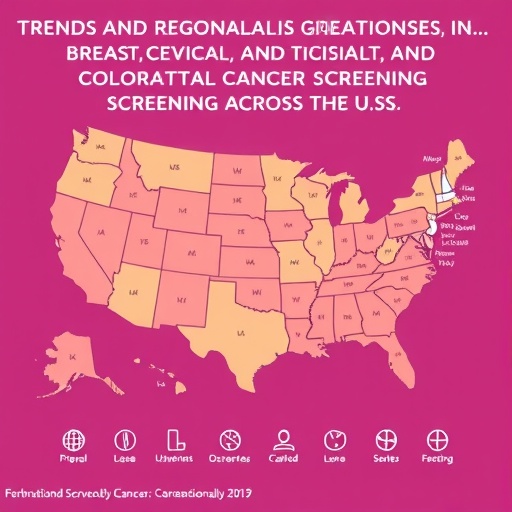In an extensive and methodologically rigorous study published in JAMA Network Open, researchers have illuminated the persistent geographic disparities in cancer screening rates across the United States, shedding light on complex patterns of health behavior and healthcare access that transcend national trends. Although overall cancer screening rates have increased, which is a promising advancement for early detection and treatment, the study reveals that localized clusters with markedly high or low screening adherence still endure, predominantly concentrated in the Northeast and the Southwest regions. This nuanced spatial persistence challenges the assumption that national improvements uniformly benefit all communities.
The investigation employed a sophisticated spatial epidemiological approach, utilizing county-level data to map screening prevalence and identify clusters through advanced geostatistical methods. These analytical strategies allowed investigators to discern areas where screening uptake is not only above or below average but also demonstrated significant spatial autocorrelation, suggesting underlying systemic or environmental factors influencing health behaviors. The researchers argue that simply increasing general population screening efforts or broad policy mandates is insufficient to address entrenched disparities.
The Northeast, a region often characterized by higher socioeconomic status and denser healthcare infrastructure, revealed clusters of elevated screening rates for common cancers including breast, cervical, and colorectal cancers. These elevated clusters are suggestive of better access to preventive health services, higher public awareness, and potentially more effective local health interventions. Conversely, the Southwest presented persistent clusters of low screening rates, raising concerns about underserved populations potentially facing barriers such as limited healthcare resources, socioeconomic disadvantages, and culturally mediated health behaviors or mistrust.
To decipher why these low-screening zones remain entrenched despite national upward trends, the study underscores the critical need to integrate healthcare access variables at the granular county level. Factors such as proximity to screening facilities, insurance coverage, physician density, and even transportation availability must be systematically included in future modeling efforts. This analytical refinement could identify the fault lines where intervention and resource allocation would be most impactful in bridging the gap between regions.
Temporal dynamics in screening behavior were also an element of the study’s analytical depth. While the national aggregate data exhibited encouraging trends in cancer screening uptake, time-series analysis revealed that while some clusters showed improvement, others stayed stagnant over years. This temporal heterogeneity contextualizes the urgency for targeted strategies that are adaptive and culturally tailored rather than monolithic. The geographic and temporal characteristics of screening behaviors are a clarion call for precision public health initiatives.
The research not only elucidates spatial disparities but implicitly raises questions about health equity and systemic healthcare delivery challenges. In regions with persistently low screening rates, patient populations could be disproportionately impacted by late-stage cancer diagnoses and subsequent mortality. Understanding the interplay between demographic variables—such as race, ethnicity, income levels, and education—and localized healthcare infrastructure will be paramount for holistic improvements.
Moreover, the study’s highlighting of regional variation in screening practices intersects with broader objectives in oncology and public health. Screening programs are foundational preventative measures within cancer control strategies. The identification of hotspot and coldspot clusters helps guide resource distribution to optimize screening adherence, reduce cancer incidence through early detection, and ultimately diminish mortality rates attributed to cancers amenable to screening.
This research also points toward implementing optimal control strategies inspired by systems theory—concepts traditionally applied in engineering and physics—to dynamically adjust interventions over time and space to maximize screening rates. Such interdisciplinary applications represent cutting-edge translational research avenues, where control theory could model the most efficient deployment of resources and healthcare outreach to influence population health behavior.
Further investigation should incorporate detailed demographic and socioeconomic data alongside healthcare system characteristics to create comprehensive multilevel models. These models could simulate interventions, predict future screening trends, and measure impacts with greater precision. Additionally, qualitative insights from community health studies could enrich understanding of cultural and psychosocial barriers impeding cancer screening uptake.
The corresponding authors emphasize that robust public policies and local healthcare programming must not only elevate awareness but also dismantle structural obstacles. Increasing provider availability, enhancing culturally competent care, and expanding insurance coverage are intertwined strategies to mitigate geographic disparities. The study advocates for a paradigm shift toward localized, data-driven cancer prevention strategies that acknowledge and adapt to regional idiosyncrasies in health service utilization.
In conclusion, while the U.S. has made commendable progress in increasing cancer screening rates nationally, this comprehensive analysis reveals that geographic disparities remain a formidable challenge. Persistent clusters of both high and low screening rates reflect complex, multifactorial influences requiring nuanced interventions. Bridging these divides demands leveraging spatial epidemiology, healthcare access data, and innovative control approaches to ensure equitable cancer prevention benefits reach every community, ultimately enhancing population health outcomes and reducing cancer burden at the national scale.
Subject of Research: Geographic variation and temporal dynamics in cancer screening rates across U.S. counties
Article Title: [Not provided in the source content]
News Publication Date: [Not provided in the source content]
Web References: [Not provided in the source content]
References: doi:10.1001/jamanetworkopen.2025.37905
Image Credits: [Not provided in the source content]
Keywords: Breast cancer, Cervical cancer, Colorectal cancer, United States population, Geographic regions, Temporal dynamics, Optimal control, Cancer, Oncology




